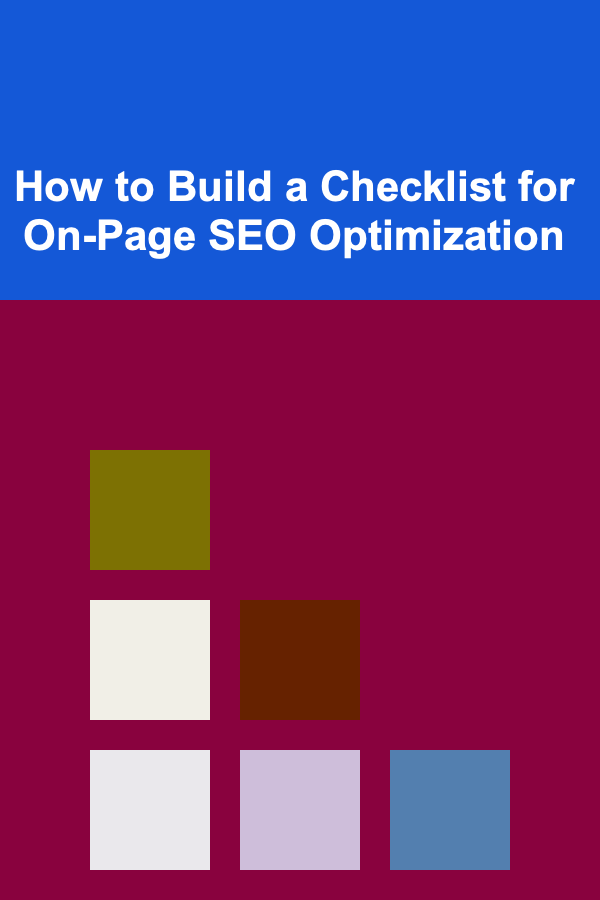
How to Build a Checklist for On-Page SEO Optimization
ebook include PDF & Audio bundle (Micro Guide)
$12.99$6.99
Limited Time Offer! Order within the next:

On-page SEO (Search Engine Optimization) is a critical aspect of digital marketing that involves optimizing individual web pages to rank higher and earn more relevant traffic in search engines. Unlike off-page SEO, which focuses on factors outside of your website (like backlinks), on-page SEO directly deals with elements on your webpage. Whether you're a seasoned SEO expert or just starting, building a detailed checklist for on-page SEO is essential for ensuring your pages are optimized for search engines and user experience.
This guide will break down actionable steps and strategies for creating a comprehensive on-page SEO checklist to improve your website's search engine visibility, user engagement, and conversion rates.
Start with a Strong Keyword Strategy
Before diving into technical optimization, it's important to develop a well-defined keyword strategy. Your content should revolve around carefully selected keywords that align with what your target audience is searching for. Here's how you can approach it:
Research Keywords
Keyword research helps you discover what terms people are searching for in relation to your business or industry. Use tools like Google Keyword Planner , Ahrefs , or SEMrush to find relevant keywords. Focus on a combination of:
- Primary Keywords: These are your main target keywords, ideally with a high search volume and low competition.
- Long-Tail Keywords: These are more specific phrases with lower search volume but higher conversion potential.
- LSI Keywords (Latent Semantic Indexing): These are related keywords that help search engines understand your content better and improve content relevance.
Focus on Search Intent
Keywords should align with the search intent---what the user expects to find. Is the user searching for information, a product, or a service? Adjust your content based on whether the intent is informational, navigational, or transactional.
Keyword Placement
Once you have your list of target keywords, it's crucial to place them strategically within your content. Here are the key locations:
- Title Tag: Place your primary keyword close to the beginning of the title.
- Meta Description: Include the target keyword to enhance visibility and click-through rate (CTR).
- Headings (H1, H2, H3): Structure your content using proper heading tags to enhance readability and SEO.
- URL: Ensure that the URL includes the primary keyword.
- Throughout the Content: Use keywords naturally within the body, but avoid keyword stuffing.
Optimize Your Title Tags and Meta Descriptions
Title tags and meta descriptions are essential components for both search engine rankings and user experience. These elements give both search engines and users a preview of what your content is about.
Title Tags
- Keep your title tag under 60 characters to ensure it displays fully in search results.
- Use your primary keyword early in the title.
- Make it compelling and clear to encourage higher CTR.
- Include your brand name at the end if relevant (for branding purposes).
Meta Descriptions
- Write meta descriptions between 150-160 characters to ensure they don't get cut off.
- Incorporate the target keyword naturally to improve visibility.
- Make it enticing by clearly describing the value of your content, prompting users to click.
Structure Content with Proper Header Tags
Header tags are crucial for content structure and readability. They also help search engines understand the hierarchy and relevance of your content.
- H1 Tag: Use only one H1 tag per page, which should contain your primary keyword. This tag is typically used for the page title.
- H2 and H3 Tags: These should be used for subheadings. Use them to break down your content into digestible sections, making it easier for readers and search engines to understand.
- Semantic Structure: Make sure your headings reflect the natural flow of your content. This enhances user experience and helps with SEO.
Optimize for Mobile-Friendliness
Mobile optimization is no longer optional---it's essential. With mobile-first indexing, Google prioritizes mobile-friendly websites in its rankings. Here's how you can optimize your pages for mobile:
- Responsive Design: Ensure your website adapts to different screen sizes.
- Fast Load Speed: Compress images, use lazy loading, and minimize JavaScript to enhance page speed on mobile devices.
- Touch-Friendly Navigation: Make sure buttons and links are easy to click on smaller screens.
Focus on User Experience (UX)
A good user experience leads to higher engagement and better rankings. Search engines prioritize websites that provide value and are easy to navigate.
Page Load Speed
- Google uses page speed as a ranking factor. Tools like Google PageSpeed Insights or GTMetrix can help you measure your load time and suggest improvements.
- Consider optimizing large image files, reducing JavaScript execution time, and leveraging browser caching to speed up page load times.
Intuitive Navigation
- Ensure that your website has clear navigation with well-organized menus, breadcrumbs, and easy-to-find search functionality.
- Make sure that content is logically organized to keep users on your site longer and encourage them to explore more pages.
Internal Linking
- Use internal links to guide users to related content within your site.
- Internal linking helps search engines understand the relationship between pages and enhances content discoverability.
- Avoid overstuffing links; only link to relevant, high-quality content.
Image Optimization
Images play an important role in user engagement, but they can also slow down your website if not optimized correctly. Follow these tips for image SEO:
File Size and Format
- Compress images without losing quality using tools like TinyPNG or ImageOptim to reduce page load time.
- Use modern formats like WebP for better compression.
Alt Text
- Write descriptive alt text for every image, including relevant keywords where appropriate. This helps search engines understand the context of the image and improves accessibility for users with visual impairments.
Image Placement
- Make sure your images are placed strategically within the content to support and enhance your message.
Ensure Your URL Structure is SEO-Friendly
A clean, descriptive URL structure can help improve both rankings and user experience.
- Short and Descriptive: Keep URLs short, relevant, and easy to read.
- Use Hyphens, Not Underscores : Google prefers hyphens to separate words in URLs (e.g.,
www.example.com/seo-tips). - Include Keywords: Incorporate your target keyword into the URL, but avoid overstuffing.
Implement Schema Markup
Schema markup (structured data) is a form of code that helps search engines understand the context of your content. By adding schema markup, you can help search engines display rich snippets in search results.
- Rich Snippets: These include additional information like star ratings, images, or prices, which can enhance your click-through rate.
- Tools : Use Google's Structured Data Markup Helper or Schema.org to add structured data to your pages.
Optimize for Content Length and Quality
Content is king when it comes to SEO. High-quality, relevant content not only satisfies user intent but also helps search engines rank your page higher.
Content Length
- Long-form content generally performs better than shorter content because it can provide more in-depth information. Aim for a minimum of 1,000 words for blog posts, depending on the topic's competitiveness.
- However, always prioritize quality over quantity. Don't artificially inflate word count just for the sake of it.
Content Uniqueness
- Avoid duplicate content as it confuses search engines and leads to penalties.
- Use tools like Copyscape to check for content duplication across the web.
Monitor Performance and Continuous Improvement
SEO is not a one-time task; it requires ongoing monitoring and optimization. Use analytics tools like Google Analytics and Google Search Console to track key metrics like organic traffic, bounce rate, and rankings.
- Audit Regularly: Perform regular SEO audits to identify areas for improvement.
- Test and Iterate: A/B test different elements like titles, meta descriptions, and content formats to see what performs best.
- Stay Updated: SEO best practices evolve constantly. Stay informed about algorithm updates and industry trends to adapt your strategy.
Conclusion
On-page SEO optimization is an ongoing process that requires attention to detail, consistency, and a strategic approach. By following this comprehensive checklist, you can ensure that your pages are well-optimized for both search engines and users. With continuous effort and by staying updated on SEO trends, you'll improve your chances of ranking higher, attracting more organic traffic, and providing a better user experience.
Reading More From Our Other Websites
- [Organization Tip 101] How to Organize Your Living Room Around a Focal Point
- [Personal Investment 101] How to Assess the Impact of Economic Changes on Property Values
- [Personal Care Tips 101] How to Use a Journal to Track Food and Feelings
- [Organization Tip 101] How to Create a Travel Checklist for Seniors
- [Home Soundproofing 101] How to Soundproof Your Home Office for Better Focus
- [Home Cleaning 101] How to Keep Your Bathroom Clean with Minimal Products
- [Home Soundproofing 101] How to Soundproof a Home with Minimal Construction
- [Organization Tip 101] How to Organize Recipes Based on Preparation Level (Beginner, Intermediate, Advanced)
- [Personal Care Tips 101] How to Choose the Perfect Perfume for Your Personality
- [Personal Care Tips 101] How to Use a Toothbrush with Whitening Toothpaste

How to Ensure Your Roth IRA is Fully FDIC Insured
Read More
How to Host a Themed Party with Simple Decorations and DIY Ideas
Read More
How to Incorporate Smart Storage in Your Home Renovation
Read More
How to Make Smart Investment Decisions During Market Volatility
Read More
How to Organize Your Grant Application for Maximum Clarity
Read More
How to Identify Edible Plants While Hiking
Read MoreOther Products

How to Ensure Your Roth IRA is Fully FDIC Insured
Read More
How to Host a Themed Party with Simple Decorations and DIY Ideas
Read More
How to Incorporate Smart Storage in Your Home Renovation
Read More
How to Make Smart Investment Decisions During Market Volatility
Read More
How to Organize Your Grant Application for Maximum Clarity
Read More